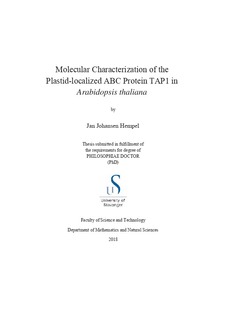| dc.description.abstract | The two TAP-like genes, AtTAP1 and AtTAP2, belong to the ABC transporter superfamily of Arabidopsis. AtTAP2/ALS1 has been shown to be important for aluminum metabolism and tolerance, however, little is known about the function of AtTAP1. This study has investigated expression dynamics of AtTAP1, the intracellular localization patterns of AtTAP1, and possible functional roles of AtTAP1 in response to a variety of biotic and abiotic stress factors.
A Yellow Fluorescent Protein (YFP) translational fusion approach showed that AtTAP1 is localized to chloroplasts, with a clear enrichment at the chloroplast membrane and indicating two different patterns of localization: short filaments in close association with the envelope or uniformly distributed with the entire surface of the chloroplast.
Using semi-quantitative RT-PCR in wild-type plants and an AtTAP1 promoter-beta-glucuronidase (GUS) construct in transgenic plants, AtTAP1 is demonstrated to have elevated expression in aerial tissues, at lateral root initiation sites and in flowers (sepals). Furthermore, AtTAP1 expression is increased in response to Ca2+ exposure, and to a lesser extent by Al3+, which is different from AtTAP2, for which lesser expression in response to Ca2+ and Fe3+ is observed. High Mg2+ represses both AtTAP1 and AtTAP2 expression, compared to the control. Preliminary observations of auxin stress treatment show an immediate repressed AtTAP1 expression before restoring during 24 hrs exposure.
Functional analysis, employing an AtTAP1 loss-of-function Arabidopsis thaliana transgenic line, attap1, revealed no phenotypic differences as compared to WT plants, in response to Al3+, Fe3+, Ca2+, Mg2+, Cu2+, methyl viologen (MV), H2O2, auxin and heat exposure, suggesting that AtTAP1 and AtTAP2 harbor very different functions. Interestingly, AtTAP1 shows enhanced expression in mechanical wounded leaf tissue indicating a possible involvement in wounding responses in plant defense.
Phylogenetic studies demonstrate essential domains of AtTAP1 and AtNAP14 to be highly conserved, and both proteins to be in closer evolutionary relationship to the homologs of N. tabacum and S. lycopersicum, than to any of the other species’ homolog TAP1 proteins compared.
AtTAP1 and AtTAP2 proteins were detected by Western Blotting. Purification and characterization were not completed, presumably due to toxicity or other inhibited protein production in the host cells. Proteins of AtNAP14 were identified and produced, without further purification and characterization. | nb_NO |

